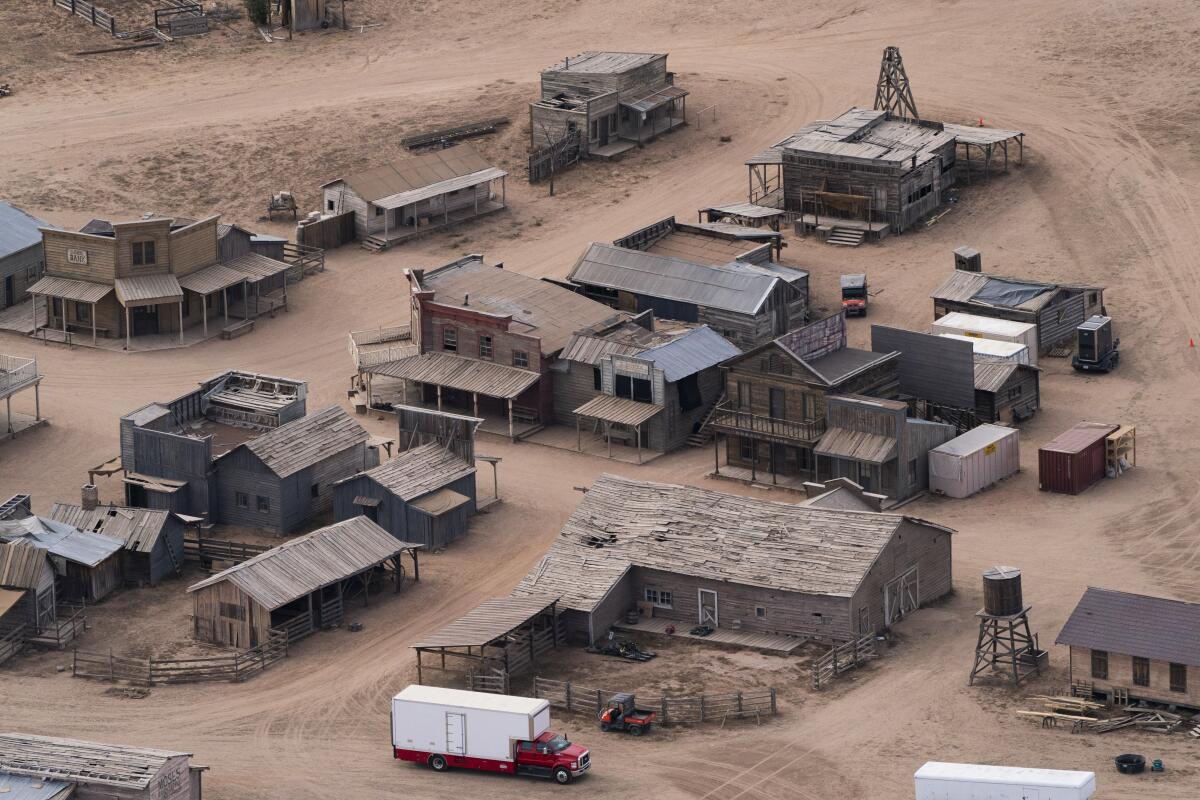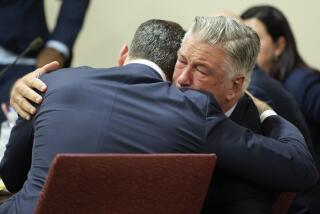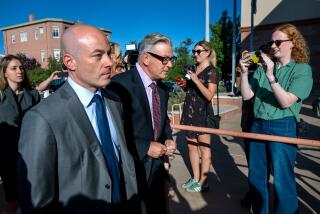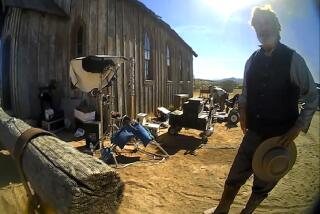‘Rust’ shooting: Who could face criminal charges in death of Halyna Hutchins?

- Share via
From the moment a gun went off on a New Mexico movie set last month, launching a bullet that killed ascendant cinematographer Halyna Hutchins, two questions have swirled around the tragic accident.
How could this happen? And who is to blame?
Unsurprisingly, many have focused on the man who was holding the weapon when it went off: actor Alec Baldwin, who was set to star in the rugged western “Rust.” But legal experts and former law enforcement officials say despite the fact that he was holding the Colt .45 revolver that killed Hutchins and wounded director Joel Souza, Baldwin may actually face the least threat of criminal prosecution out of anyone who handled the weapon that day.
Rather, experts say, assistant director David Halls and set armorer Hannah Gutierrez Reed are in far more danger of facing a manslaughter charge in Hutchins’ death if New Mexico 1st Judicial Dist. Atty. Mary Carmack-Altwies decides anyone should face prosecution.
“Alec Baldwin may very well have pulled that trigger, and that bullet may have killed that woman, but what’s crucial to the criminal justice system, is what he knew or should have known,” said Laurie Levenson, a former federal prosecutor who now serves as a professor at Loyola Law School in Los Angeles. “It’s not enough to just say that his fingerprints are on that trigger.”
While Baldwin’s conduct appeared to run counter to common sense gun safety rules — there’s no indication that he checked to see whether the weapon was loaded or attempted to point it in a safe direction — legal experts said the fact that Baldwin was following directions from others and rehearsing a scene on a movie set at the time severely lessens his culpability.
Legal observers say prosecutors are likely to focus on the behavior of those who would have been responsible for care of the weapons and safety on set.
Several experts told The Times they were concerned by statements Halls made to Santa Fe County Sheriff’s Office investigators after the shooting, statements that were revealed in an affidavit for a search warrant made public last week. Halls told detectives he saw three rounds in the revolver before it was given to Baldwin and acknowledged he “should have checked all of them, but didn’t,” according to the affidavit.
“That speaks very strongly to criminal negligence. That’s a ‘you had one job’ sort of thing,” said Pat McLaughlin, a retired New York City police detective who teaches forensic science at the John Jay School of Criminal Justice in Manhattan. “If you’re not double-checking this type of thing, you’re creating an exponential risk of having a tragic accident.”
Authorities in New Mexico have not provided a timeline for their investigation. During her lone public news briefing since the shooting, Carmack-Altwies said her office had not ruled out charges against anyone.
Court documents have described Halls as the person who handed the weapon to Baldwin and announced “cold gun,” signaling the revolver was loaded only with blanks. In public comments made since the release of the affidavit, Halls’ attorney, Lisa Torraco, has disputed the claim that the assistant director gave Baldwin the weapon or that he failed to examine the rounds in the chamber, directly contradicting remarks her client made to detectives, according to the affidavit. She also contended gun safety was not Halls’ responsibility.
Torraco has not responded to requests for comments from The Times. But legal experts said Halls and Gutierrez Reed would both have been responsible for gun safety on set.
“Both of them failed to do their job. For a gun to be laying around a movie set with a live bullet in it is unfathomable,” said David Ring, a Los Angeles plaintiffs attorney who has won a number of high-profile personal injury cases. “So the two people who somehow let that happen are the assistant director and the armorer, and they’re both going to be exposed to criminal liability for it.”
Halls told investigators that Gutierrez Reed normally “spun” the cylinder of the revolvers on set before they were handed to actors, but wasn’t sure if she did so the day of the shooting. Gutierrez Reed’s attorney, Jason Bowles, issued a statement earlier this week contending she had done so.
During a live interview last week, Bowles also made a bizarre suggestion that someone may have mixed live rounds in with the blanks normally used on set to “sabotage” the production, but offered no proof of his claims. Bowles has not responded to requests for comment from The Times.
Even that wild allegation might not help the armorer’s potential defense, according to McLaughlin, who pointed to Gutierrez Reed’s admission in the affidavit that ammunition was “left on a cart on the set, not secured” before the shooting.
“You left it unattended. Any number of people could have interacted with that ammunition while you weren’t there,” he said, adding that it would be the armorer’s “job to account for every piece of ammunition.”
If Gutierrez Reed were to be charged, it wouldn’t be the first time a Hollywood set’s munitions expert was brought to trial after a death during filming. When prosecutors filed manslaughter charges in the infamous 1982 helicopter crash that left actor Vic Morrow and two children dead while filming “Twilight Zone: The Movie,” the special effects coordinator was among the five defendants charged.
Prosecutors argued the bomb blasts used in the scene that went fatally wrong were unnecessarily powerful and that the coordinator’s negligence and recklessness were partially to blame. A jury ultimately acquitted on all charges.
Levenson said charges could also extend beyond those physically present the day Hutchins died, if police and prosecutors uncover a pattern of misconduct or unsafe working conditions on set. In 2015, a producer on the film “Midnight Rider” was charged with manslaughter after an assistant camera operator was killed by debris kicked up by a train that slammed into a set trestle during filming on the Georgia-based biopic about Gregg Allman.
The production did not have permission to film in the area and were in the middle of a shoot when a scheduled train hurtled toward them. Executive producer Jay Sedrish was sentenced to 10 years’ probation even though he wasn’t on set at the time of the wreck.
Santa Fe County Sheriff Adan Mendoza has acknowledged he is investigating rumors that people were engaging in target shooting on set, and his detectives recovered live ammunition from the ranch where the movie was being filmed. Crew members told The Times there were at least three prior accidental discharges on set, including an incident where a props department employee “shot herself in the foot” with a blank.
If a police investigation corroborates such reports, or a likely search of emails and other communications between staff uncovers similar incidents, producers or executives could also face the risk of criminal exposure, experts said.
“You often hear the buck stops here, and it is possible there are people higher up ... who have responsibilities to make sure the set was safe even if they weren’t on the set,” Levenson said. “You don’t have to be on the location when the gun is fired to have responsibility.”
Hutchins’ death has stirred up memories of another shooting death on a movie set, that of actor Brandon Lee during filming of “The Crow” in 1993 in North Carolina. Lee was shot in the spine with a .44 caliber bullet fired from a weapon supposedly able to launch only blanks. Prosecutors, however, ultimately declined to file charges, noting they could not prove conditions on the set amounted to “willful and wanton” negligence.
More to Read
Sign up for Essential California
The most important California stories and recommendations in your inbox every morning.
You may occasionally receive promotional content from the Los Angeles Times.










